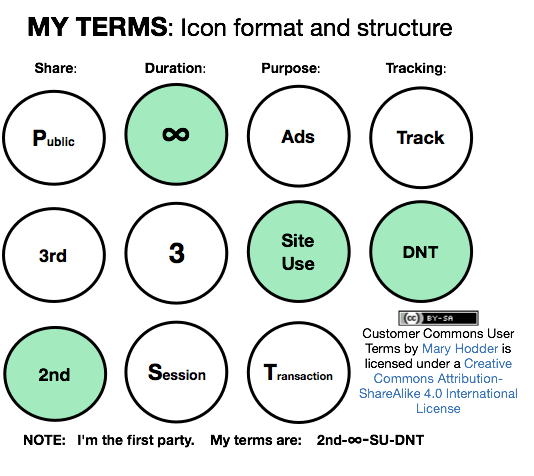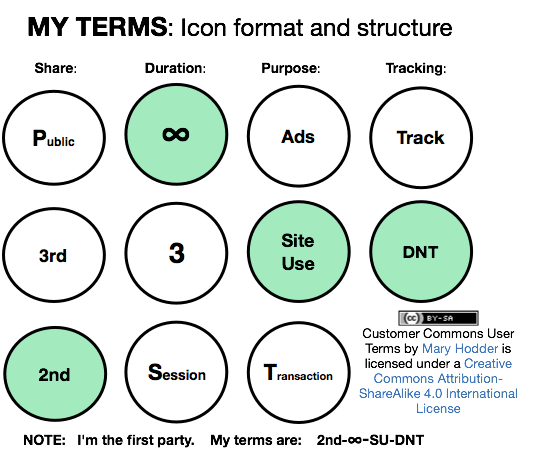Dealing with Boundary Issues

The other evening a bunch of us were sitting in a friend's living room while a series of photos scrolled across her TV. The photos were a screen saver served up by her new Apple TV box. Some of the pictures were of people, birds, flowers, cats and other typical stuff. But in the mix were also shots of price tags, bar codes, bags of mulch and other stuff she had thought about buying at some point.
"What are those doing there?" somebody asked.
"I don't know," she said. "I thought I threw those away."
"That's scary," somebody said. "What if some of your shots were nude selfies, or porn?"
"I don't have that," she replied. "But I don't like not knowing why shots I never intended to share are showing up on my TV."
Even though most people in the room
were Apple customers, and some knew a bit about Apple TV, the room
itself had no clear sense about how Apple TV decides what photos to
show, or whether the
photos on the screen come from the user's phone, laptop or iCloud
(the
non-place where Apple may
or may not store some or all of what customers shoot with their
cameras or phones). So finally a rough agreement emerged out of
collective un-knowing.
"It's probably the cloud," somebody said.
"Yeah, the damn cloud," another agreed. What else to blame than the
most vague thing they all knew?
Then my wife said something that
knocked me over.
"The cloud has boundary issues."
Her point was about the psychology of the cloud, not its technology.
In psychology, boundary issues show up when one person doesn't respect
the boundaries set by another. And in today's networked world, personal boundaries are ignored as a matter of course, mostly because people don't have ways to set them.
In pre-Internet days, personal computers came with their own built-in boundaries. Even when they were connected to shared printers and file systems, it was clear where the personal stuff ended and the shared stuff began.
In today's networked world, smart geeks mostly still know where
local stuff ends
and remote (cloud-located) stuff begins — or at least where the logical
boundaries are. But for most of the rest of us, most of the time, the
cloud is a hazy thing. And that haze has been troubling us ever since
we chose "the cloud" over better terms that would have made more sense.
(Such as calling it a "utility", which Nicholas Carr suggested in his
2010 book The Big Switch.)
According to Google's Ngram Viewer, mentions of "cloud computing" in books hockey-sticked in 2004 and continued to rise after that. Usage of "the cloud" also rose over the same period. According to Google Trends, which looks at search terms, "the cloud" hockey-sticked in 2011 and flattened after that, because its usage became ubiquitous.
William F. Buckley Jr. once said his purpose in life was "to stand athwart history, yelling 'stop.'" In a similar way Richard M. Stallman stood athwart history when, in
September 2008, he called
the cloud "worse than stupidity: it's a marketing hype campaign," In What
Does That Server Really Serve?, published in March 2010, RMS wrote,
The information technology industry discourages users from considering ... distinctions. That’s what the buzzword "cloud computing" is for. This term is so nebulous that it could refer to almost any use of the Internet. It includes SaaS, and it includes nearly everything else. The term only lends itself to uselessly broad statements.
The real meaning of "cloud computing" is to suggest a devil-may-care approach towards your computing. It says, "Don’t ask questions, just trust every business without hesitation. Don’t worry about who controls your computing or who holds your data. Don’t check for a hook hidden inside our service before you swallow it." In other words, "Think like a sucker." I prefer to avoid the term.
About SaaS (Software as a Service) he adds,
These servers wrest control from the users even more inexorably than does proprietary software. With proprietary software, users typically get an executable file, but not the source code. That makes it hard for programmers to study the code that is running, so it’s hard to determine what the program really does, and hard to change it.
With SaaS, the users do not have even the executable file: it is on the server, where the users can’t see or touch it. Thus it is impossible for them to ascertain what it really does, and impossible to change it.
Furthermore, SaaS automatically leads to harmful consequences equivalent to the malicious features of certain proprietary software. For instance, some proprietary programs are “spyware”: the program sends data about users’ computing activities to the program’s owner...
SaaS gives the same results as spyware because it requires users to send their data to the server. The server operator gets all the data with no special effort, by the nature of SaaS.
And, sure enough, spying on individuals by commercial entities is now so normal and widespread that most of us living in the networked world can hardly tell when it's not happening. This is why ad and tracking blockers have become so popular, and why survey after survey show that more than 90% of people are concerned about privacy online.
But spying is just the symptom. The deeper issue is boundaries. In the networked world we don't have them, and because of that others take advantage of us.
"Give me a place to stand and I can move the world," Archimedes said. Note that he didn't say, "Give a lot of people a place to stand." He meant himself. And his point applies to personal boundaries as well. Each of us needs to set our own. That's our fulcrum.
Free software provides a good model for approaching this problem, because its framing is personal:
"Free software" means software that respects users' freedom and community. Roughly, it means that the users have the freedom to run, copy, distribute, study, change and improve the software. Thus, "free software" is a matter of liberty, not price... We campaign for these freedoms because everyone deserves them.
Most of us don't write software, but all of us create and use
data. We also have containers for data in our computers. We call
those containers files, which live in directories,
which are visualized as folders in graphical user interfaces.
As a mental concept, containers could hardly be more important. In The
Metaphorical Structure of the Human Conceptual System, George
Lakoff and Mark Johnson say,"the nature of the human conceptual system
... is fundamentally metaphorical in character" and involves
"ontological concepts arising in physical experience, among which is
the container." They provide examples:
When you have a good idea, try to capture it immediately in words. Try to pack more thought into fewer words. His words carry little meaning. Your words seem hollow. The ideas are buried in terribly dense paragraphs. I can’t get the tune out of my mind. He’s empty-headed. His brain is packed with interesting ideas. Do I have to pound these statistics into your head? I need to clear my head.
All those statements presume containers: spaces with boundaries. We have those with files, directories, folders, drives and storage systems. We don't with clouds, beyond knowing that something resides "in the cloud." We also don't with cookies and tracking beacons that get injected (from clouds) into who-knows-where inside our computers and mobile devices.
One reason this happens is because, in the online world, we lack the privacy-providing containers we call clothing and shelter. The closest equivalents are our disconnected machines. Want privacy? Stay off the Net.
But we can't. So we venture out in browsers: our car on the Net's and the Web's highways and byways. The space contained in our browsers ought to be as private and personal as the ones inside our homes, our clothes and our cars. Yet it has long been the norm for websites to put tracking files inside our browsers, to report our activities back to parties we don't know, all so they can give us a better "advertising experience" or whatever. Dislike of these intrusions, and what they produce, are why ad and tracking blockers have become so popular. (I've written about them extensively in my Adblock War Series where this column will be listed as well).
In the absence of boundaries we set, controlling entities assume that boundary-setting is their job and not ours. After all, the presumptive logic goes, so much of the world's work can only be done by big systems that enjoy degrees of "scale" not available to individual human beings.
Yet personal freedom has scale too, if it is grounded in our nature as sovereign and independent human beings. This is why we employ ad and tracking blockers, and why free software was such a powerful idea in the first place, and why it remains the world's most rigorous guide for software development. We may not always obey it, but we always know it's there, and why it is valuable.
While free software respects code and what can be done with it, we
need a similar set of guiding principles that respect personal data and what can be done with that. I
believe these should be terms that we assert, and to which others can
agree, preferably automatically.
In fact there is a lot of work going on right now around personal terms. I am involved with some of it myself, through Customer Commons. Here is one straw-man example of terms, drawn up by Mary Hodder at the 19th Internet Identity Workshop (IIW) last year:

Figure 1. User Terms (from Mary Hodder at the 19th Internet Identity Workshop)
Terms and privacy policies (that we assert, as individuals) will also be on the table at two events this month.
The first is the 21st IIW, which takes place twice per year at the Computer History Museum, in the heart of Silicon Valley. It's a three-day unconference, with no keynotes and no panels: just breakouts on topics of the participants' choosing. It costs money, but is cheap compared to most other conferences, and far more intense and productive than any other conference I know. The dates are October 27-29. Register here.
The second is VRM Day, which happens on October 26, the day before IIW, in the same location. The purpose is to discuss VRM (Vendor Relationship Management) development, which is all about freedom and independence for individuals in the commercial world. It's free, and you can register here.
See you there.
Resources
Mentions of "cloud computing" in books according to Google's Ngram Viewer (2000–2008): https://books.google.com/ngrams/graph?content=cloud+computing&year_start=2000&year_end=2008&corpus=15&smoothing=3&share=&direct_url=t1%3B%2Ccloud%20computing%3B%2Cc0t1;,cloud%20computing;,c0
Usage of "the cloud" in books according to Google's Ngram Viewer (2000–2008): https://books.google.com/ngrams/graph?content=the+cloud&year_start=2000&year_end=2008&corpus=15&smoothing=3&share=&direct_url=t1%3B%2Cthe%20cloud%3B%2Cc0t1;,the%20cloud;,c0
Google Trends "the cloud" search term (2004 to present): https://www.google.com/trends/explore#q=%22the%20cloud%22
William F. Buckley, Jr.: https://en.wikipedia.org/wiki/William_F._Buckley,_Jr.
+-------Richard M. Stallman: https://stallman.org
"Cloud computing is a trap, warns GNU founder Richard Stallman" by Bobbie Johnson: https://www.theguardian.com/technology/2008/sep/29/cloud.computing.richard.stallman
"What Does That Server Really Serve?" by Richard M. Stallman: https://www.bostonreview.net/richard-stallman-free-software-DRM
The 2015 Ad Blocking Report by the PageFair Team: https://blog.pagefair.com/2015/ad-blocking-report
"Americans' Attitudes About Privacy, Security and Surveillance" by Mary Madden and Lee Rainie (Pew Research Center): https://www.pewinternet.org/2015/05/20/americans-attitudes-about-privacy-security-and-surveillance
2015 TRUSTe US Consumer Confidence Index: https://www.truste.com/resources/privacy-research/us-consumer-confidence-index-2015
"Lying and Hiding in the Name of Privacy" by Mary Hodder and Elizabeth Churchill (Customer Commons): https://customercommons.org/2013/05/08/lying-and-hiding-in-the-name-of-privacy
Philosophy of the GNU Project: https://www.gnu.org/philosophy/philosophy.en.html
The Free Software Definition: https://www.gnu.org/philosophy/free-sw.en.html
"The Metaphorical Structure of the Human Conceptual System" by George Lakoff and Mark Johnson: https://www.fflch.usp.br/df/opessoa/Lakoff-Johnson-Metaphorical-Structure.pdf
Customer Commons: https://customercommons.org
Vendor Relationship Management (VRM): https://en.wikipedia.org/wiki/Vendor_relationship_management

